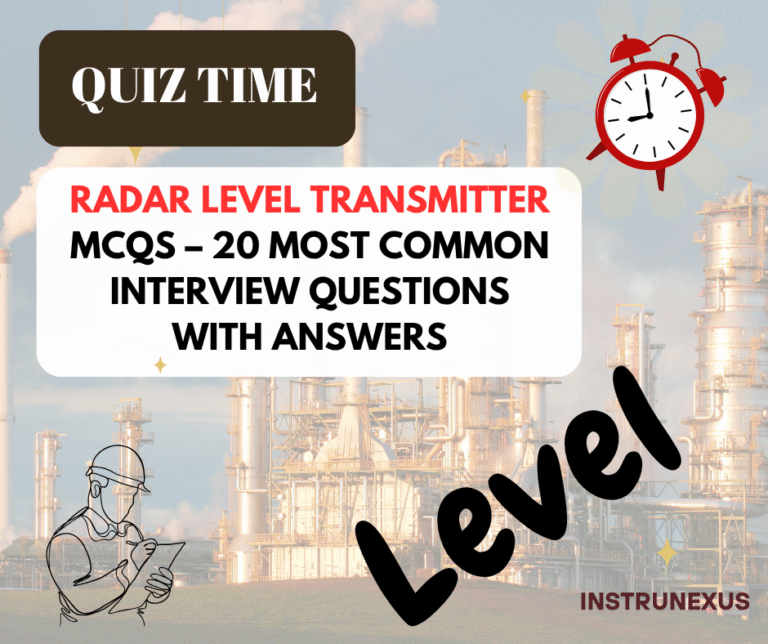

🔹 1. What is a radar level transmitter?
Answer:
A radar level transmitter is a non-contact type level measurement device that uses microwave radar signals to measure the level of liquids or solids in a vessel based on the time-of-flight principle.
🔹 2. What is the working principle of a radar level transmitter?
Answer:
It operates on the Time of Flight (ToF) principle, where a radar pulse is transmitted towards the medium, and the time taken for the signal to reflect back from the surface is measured to calculate the distance, hence the level.
🔹 3. What are the two main types of radar level transmitters?
Answer:
-
Pulsed radar (Time domain reflectometry – TDR)
-
Frequency Modulated Continuous Wave (FMCW) radar
🔹 4. What is the typical frequency range used in radar transmitters?
Answer:
Common frequency bands:
-
6 GHz (older models)
-
10 GHz
-
26 GHz
-
80 GHz (latest, with higher accuracy and better focusing)
🔹 5. What are the advantages of using radar level transmitters?
Answer:
-
Non-contact measurement
-
High accuracy and reliability
-
Suitable for harsh process conditions
-
Unaffected by temperature, pressure, and vapor
🔹 6. Where are radar level transmitters commonly used?
Answer:
-
Storage tanks
-
Process vessels
-
Reactors
-
Silos (for solids)
-
High-pressure or high-temperature applications
🔹 7. What is dielectric constant, and why is it important in radar level measurement?
Answer:
The dielectric constant (DK) determines how well a material reflects radar signals. A higher DK means better signal reflection. Liquids with DK > 2 are usually measurable.
🔹 8. How does the tank geometry affect radar performance?
Answer:
Conical roofs, narrow nozzles, and internal obstructions can cause multiple reflections or dead zones, affecting accuracy. Guided wave radar is preferred for such geometries.
🔹 9. What is the difference between guided wave radar (GWR) and non-contact radar?
Answer:
-
GWR: Uses a probe or rod to guide the signal
-
Non-contact radar: Emits signals through air without any contact
🔹 10. Can radar transmitters measure interface levels?
Answer:
Yes, guided wave radar can measure the interface between two liquids (e.g., oil and water) if there is a sufficient DK difference.
🔹 11. What are dead zones in radar level measurement?
Answer:
Dead zones are areas near the top or bottom of the tank where accurate measurement is not possible due to signal reflection limitations.
🔹 12. What are common materials used for radar antenna?
Answer:
-
PTFE (Teflon)
-
Stainless steel horn
-
Plastic lenses for high-frequency radar
🔹 13. How do foam and vapors affect radar measurements?
Answer:
-
Dense foam can absorb or scatter radar signals, reducing accuracy
-
High-frequency radar (like 80 GHz) performs better in such conditions
🔹 14. What is the minimum DK required for reliable radar measurement?
Answer:
A minimum DK of 1.6 to 2.0 is typically required. Lower DK values may result in weak reflections.
🔹 15. How is the radar signal affected by turbulence or agitation?
Answer:
Turbulence can cause signal dispersion or erratic readings. Guided wave radar offers better stability in such conditions.
🔹 16. Can radar level transmitters be used in vacuum applications?
Answer:
Yes, radar is ideal for vacuum applications as it doesn’t rely on pressure and is unaffected by vacuum conditions.
🔹 17. What are typical outputs of radar level transmitters?
Answer:
-
4–20 mA analog signal
-
HART communication
-
Foundation Fieldbus or Profibus PA
-
Modbus, WirelessHART in smart models
🔹 18. What is false signal suppression or mapping?
Answer:
It’s a feature where known obstructions (like agitators or ladders) are taught to the transmitter to ignore their reflections, preventing false readings.
🔹 19. How do you calibrate a radar level transmitter?
Answer:
Most radar transmitters are factory calibrated. Field configuration involves setting tank height, empty and full reference levels using HART communicator, DCS, or software.
🔹 20. What is the difference between 26 GHz and 80 GHz radar?
Answer:
-
26 GHz: Wider beam angle, may reflect off tank internals
-
80 GHz: Narrow beam, better focusing, ideal for small nozzles or tanks with internals
